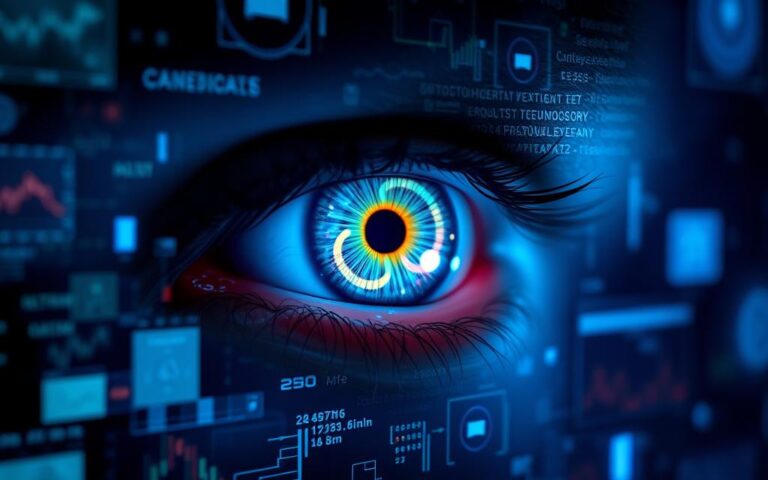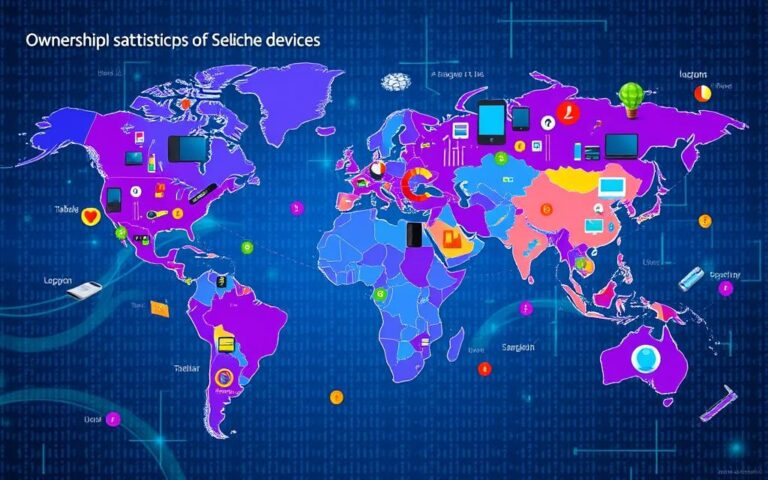Role of Technology in “Fahrenheit 451”
Ray Bradbury’s “Fahrenheit 451” critiques technology’s huge impact on society. It is set in a dystopian future. The story shows how technology, especially media influence, leads to societal control. It also shows the loss of real human connection.
Mildred, a character, spends too much time watching her three parlour wall televisions. This represents a deep dependency on digital entertainment. People prefer virtual relationships over real ones. This causes them to lose touch with reality and ignore important social issues.
The story reveals how technology causes problems in Fahrenheit 451. This includes being numb to violence and worsening mental health, seen in Mildred’s character. Bradbury warns us of a future. In this future, technology could overpower real human interactions and thoughtful deliberation.
The book pushes readers to think about technology’s good sides and its dangers. It explores how it can harm our social ties. Bradbury’s message is increasingly relevant today. It encourages us to examine how technology affects us. It makes us question its role in our lives.
Introduction to the Dystopian World of “Fahrenheit 451”
“Fahrenheit 451” by Ray Bradbury takes readers into a scary dystopian world. It shows the risks of too much control and censorship in society. Written in 1953, it reflects a time of big social and tech changes. The book imagines a future America where tech is used to oppress, not enlighten.
Understanding Ray Bradbury’s Vision
Bradbury imagined a world where the media controls everything, leading to a lack of free thought. The Parlor Walls, huge screens for entertainment, show how tech can distract and addict. Instead of encouraging deep thinking, these technologies make people passive.
Context of Technological Influence
In “Fahrenheit 451”, technology, like the Mechanical Hound, shows the scary side of surveillance and control. The Hound hunts those who disagree, showing how oppression works. This fits Bradbury’s fear of total control and mirrors today’s concerns about privacy and tech.
The story also warns about the dangers of censorship. A government burns books, wiping out different ideas and changing how we know things. This warning about a too agreeable society reflects Bradbury’s fear for our personal freedoms.
| Year | Technological Advancement | Significance |
|---|---|---|
| 1951 | 1.5 million TV sets sold | Rise of television culture |
| 1994 | Bluetooth headphones invented | Advancement in personal audio technology |
| 2001 | In-ear headphones introduced | Enhanced personal listening experiences |
| 2012 | Wireless headphones gain popularity | Sign of growing individualism and technological reliance |
How is technology used in “Fahrenheit 451”?
Ray Bradbury’s “Fahrenheit 451” looks at how tech shapes a world where people love media too much. It shows us a scary future where tech changes how society works. It warns us about losing touch with each other because of our tech addictions, shown through people like Mildred Montag.
Media Consumption and Its Effects on Society
In this story, we see how loving media too much can harm our ability to think and care. Mildred Montag’s life revolves around fake worlds created by big TVs. This keeps everyone from seeing what’s really happening, letting the government control them by making up stories.
This book’s view on tech shows us how easy it is to feel alone even when we’re always “connected.” It’s like what we face today with our own battles with too much screen time. The technology described in the novel makes us think about our real-life tech challenges.
The Role of Firemen and Censorship
In the book, firemen don’t put out fires; they start them to burn books. This twist shows how far the government will go to keep control and stop people from thinking freely. Firemen become the bad guys, pushing the government’s agenda to keep people in the dark.
The Mechanical Hound is a scary tool used to keep tabs on everyone. It’s a clear sign of how too much tech can strip away our humanity. In this world, knowing too much becomes dangerous, showing how controlling tech can limit our freedoms.
The Impact of Technology on Human Relationships
“Fahrenheit 451” by Ray Bradbury is a stark warning about technology and its effects on people’s connections. It shows how tech can lead to more isolation, not closeness. Mildred Montag, a key figure in the story, chooses her TV over her husband, Guy Montag. This illustrates how shallow relationships can become with too much technology, where real feelings are rare.
Mildred Montag’s Connection to Television
Mildred’s fixation with TV highlights the isolation in her life. Instead of building real connections, she gets attached to TV characters and stories. This preference for fake entertainment over real interactions leaves an emotional gap. Bradbury uses Mildred to show a society that leans on technology and ignores the value of real human connections, leading to an unfulfilled life.
Isolation in a Technological Society
Isolation is a key theme in the story, made worse by constant technology use. Characters pull away from reality into virtual worlds. Technology drives people apart, reducing real conversations. Data shows that devices make families talk less, lowering the chance for real bonding. As Mildred turns to her “TV family,” readers see how technology can block real emotional connections.

| Aspect | Impact of Technology |
|---|---|
| Emotional Investment | Prioritises fictional over real relationships |
| Communication Frequency | Significant decline in meaningful conversations |
| Sense of Happiness | False happiness induced by technology |
| Real-World Engagement | Isolation from nature and authentic experiences |
Bradbury touches on the vital need for balance with technology in our lives. The story reminds us that technology should enhance, not replace, deep human connections that truly bring joy and meaning to our lives.
Desensitisation and Distraction in “Fahrenheit 451”
In “Fahrenheit 451,” escaping reality and distraction are main themes through the main character’s fight against a tech-heavy society. People avoid facing their feelings, diving into senseless fun. Mildred’s overdose shows how deep emotional avoidance runs in her life.
Escapism and the Avoidance of Reality
Mildred loves her TV, showing a common trend of escaping problems. People watch interactive shows, losing their ability to think critically. This leads to a lack of care for others. Many choose entertainment over real connections, making distraction a cycle. This weakens genuine human bonds, leaving people indifferent to what’s around them.
The story criticises society for valuing shallow over deep thinking and freedom, showing the harm of an entertainment-focused life.
Violence as a Normalised Aspect of Life
Bradbury shows how society ignores brutality, making violence normal. Media full of violent images makes people care less about real suffering. This shows how harmful sensational media can be. Censorship and burning books make people numb, focusing on stopping information rather than sharing it.
Technology’s huge role allows for much control over information and actions. Media makes people numb to violence and shapes what they see as right, making violence normal.
| Statistic | Details |
|---|---|
| Percentage of Individuals Reporting Book Possession | High levels of fear and surveillance |
| Ratio of Book Burning to Firemen Interventions | Predominance of censorship |
| Frequency of Media Consumption | Overwhelming presence of distraction |
| Number of References to Specific Authors | Correlation with censorship levels |
| Percentage Favouring Entertainment over Connections | Shift towards societal apathy |
| Integration of Technology in Daily Life | Influence on behaviour and norms |
Bradbury warns us to think again about our relationship with technology, showing the dangers of too much escapism. As people grow more numb, it’s up to society to find its way again, despite so many distractions.
Conclusion
The story of “Fahrenheit 451” by Ray Bradbury criticises where modern society might be heading. It talks about the dark sides of too much tech use. It shows how this can harm how we think, connect with others, and act in society.
As the story goes on, we see technology might make life easier but also makes us feel more alone. Bradbury contrasts real, meaningful talks with just watching or listening to things. For example, Mildred Montag loves her “parlour walls” too much. Today, many parents use gadgets to keep their kids calm. This mirrors our shift towards easy fixes instead of real connections.
In the book, people become emotionally cold and distant. This is a big problem for everyone’s understanding and togetherness.
In the end, “Fahrenheit 451” warns us. It says we should find a good middle ground between tech growth and keeping our human values. Bradbury’s story matches today’s issues with technology. It encourages readers to think deeply about how we use technology. It should add to our lives, not take away from real, human connections.
FAQ
What is the main theme of technology in “Fahrenheit 451”?
The main theme is about technology being used wrongly. It shows how this misuse leads to censorship and less critical thinking. Ray Bradbury shows that technology can control and numb society. This makes people care less about things that matter.
How does Ray Bradbury portray the influence of media in the novel?
Bradbury shows that too much media is bad for society. It makes people stop thinking on their own. Because of too much TV, characters lose touch with real life. They miss out on real human connections and ignore big problems in society.
What role do firemen play in “Fahrenheit 451”?
Firemen in the book do the opposite of what we expect; they start fires to burn books. This act shows the lengths taken to stop free thought. It’s a clear sign of the government controlling knowledge.
How does technology affect human relationships in the story?
Technology in the book leads to people being alone. For example, Mildred Montag likes fake friends more than real ones. This shows how tech can hurt our connections with others. It makes relationships weak and not genuine.
What does “Fahrenheit 451” suggest about escapism and distraction?
The book is critical of escapism. It talks about characters using media to ignore real issues. This leads to a society that doesn’t care about important matters. Violence becomes something they just accept. It’s a warning about ignoring the real world.
How does Bradbury’s vision reflect contemporary issues surrounding technology?
Bradbury’s concerns about technology still matter today. Our world is full of chances to twist information. People can become numb to what’s really important. The book tells us to be careful with tech. It says we should balance tech use with keeping our human values.









